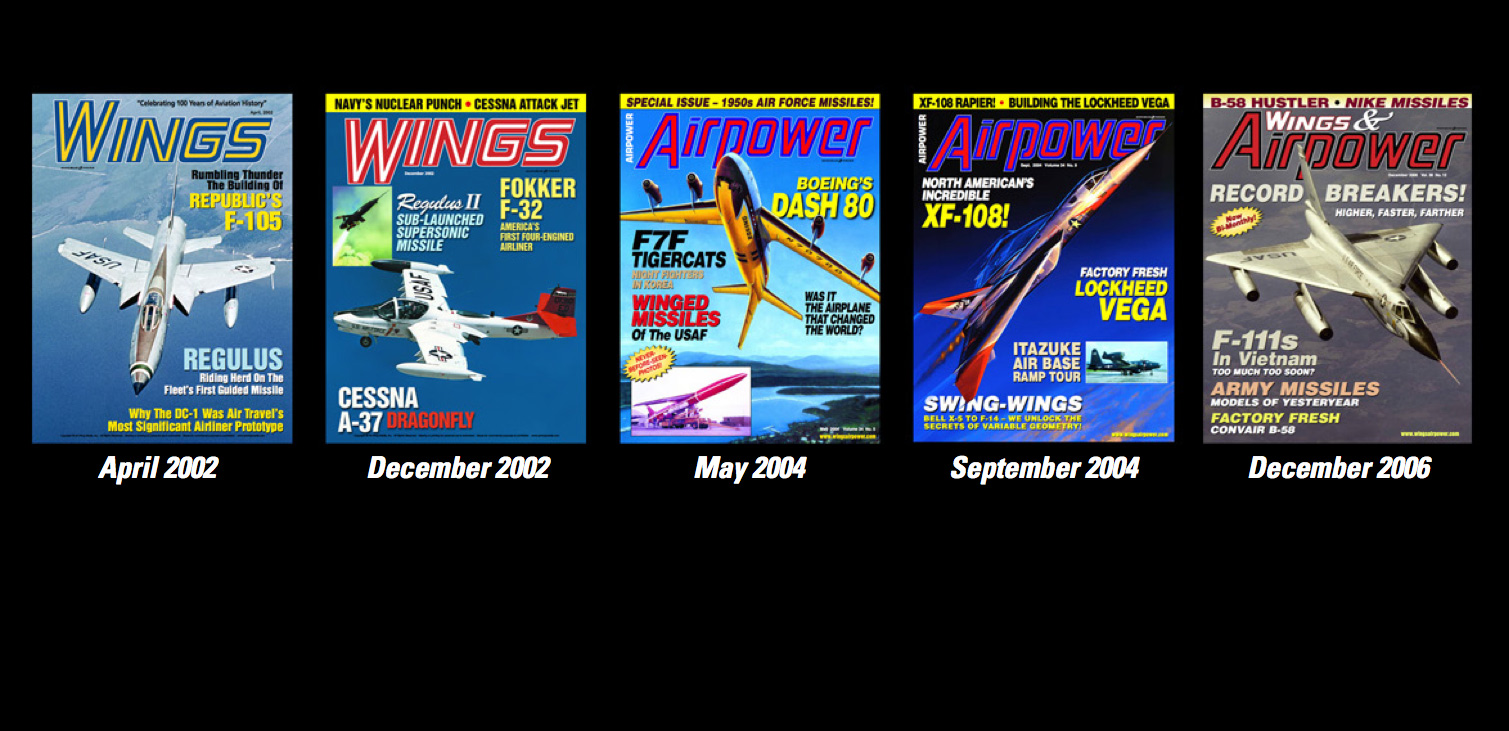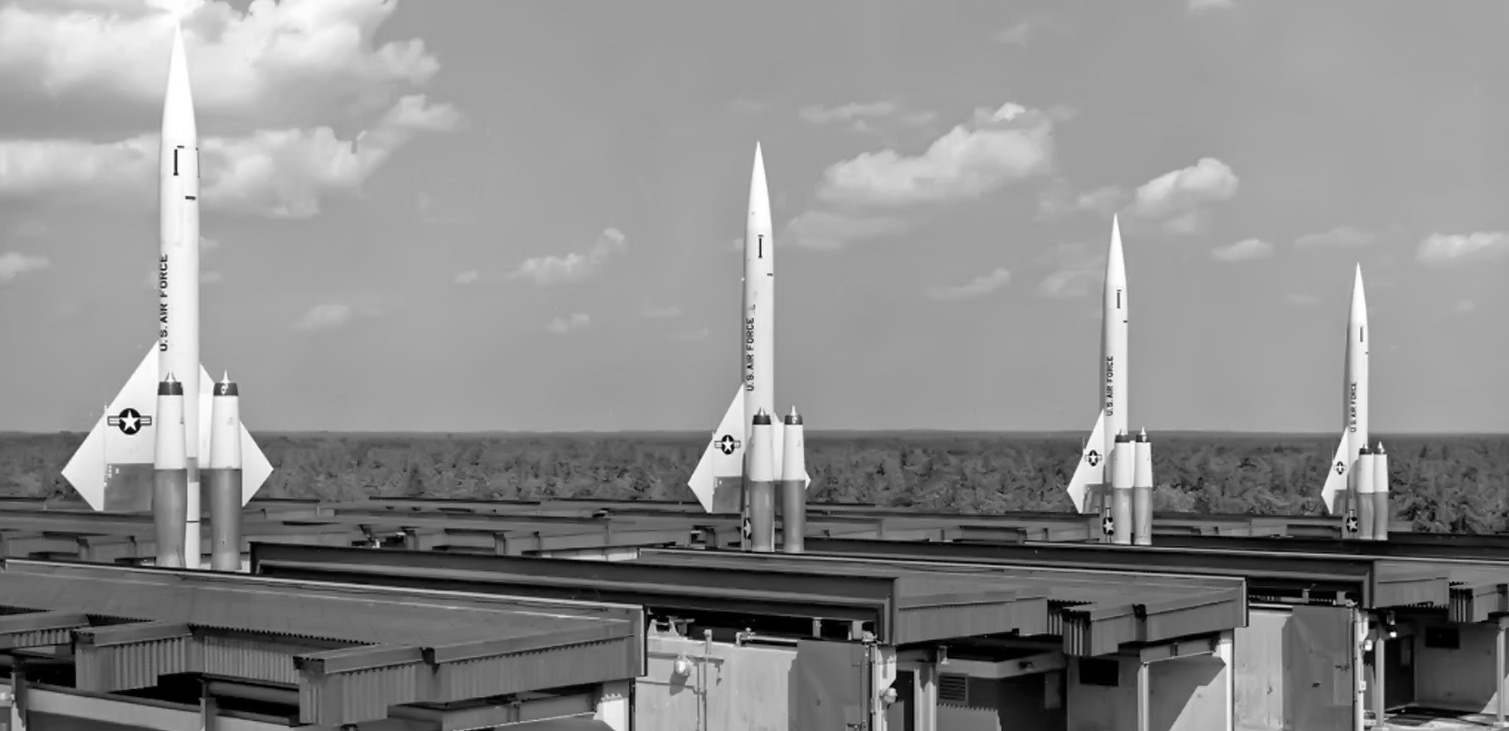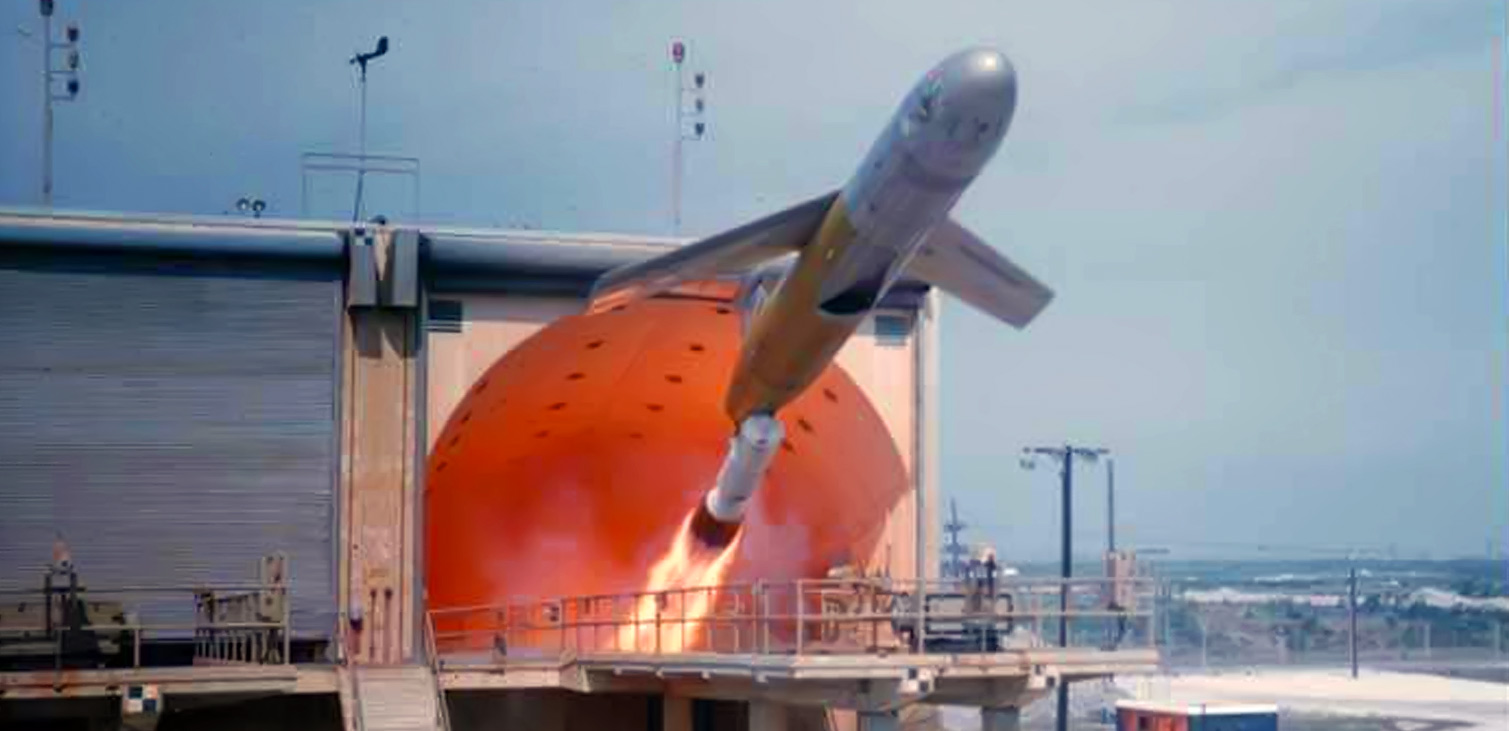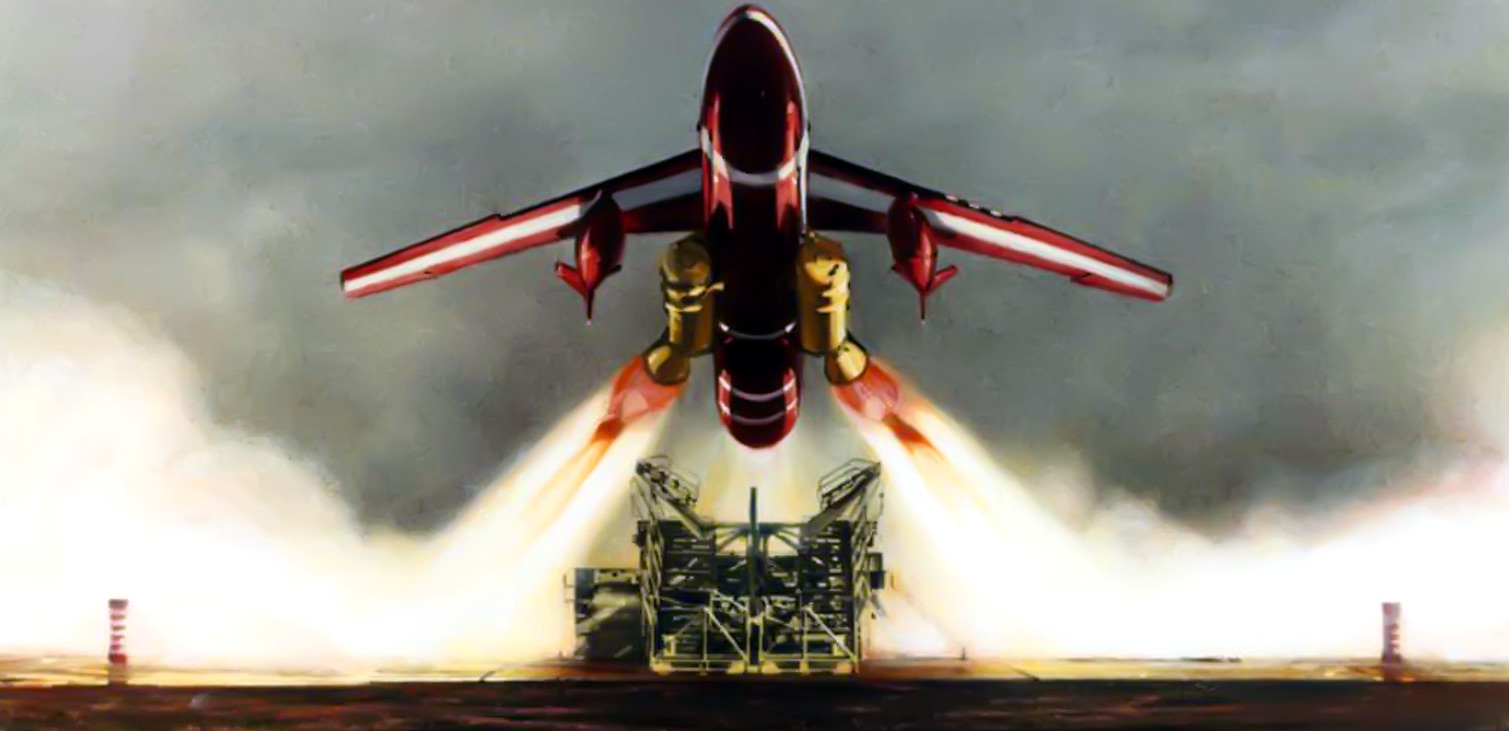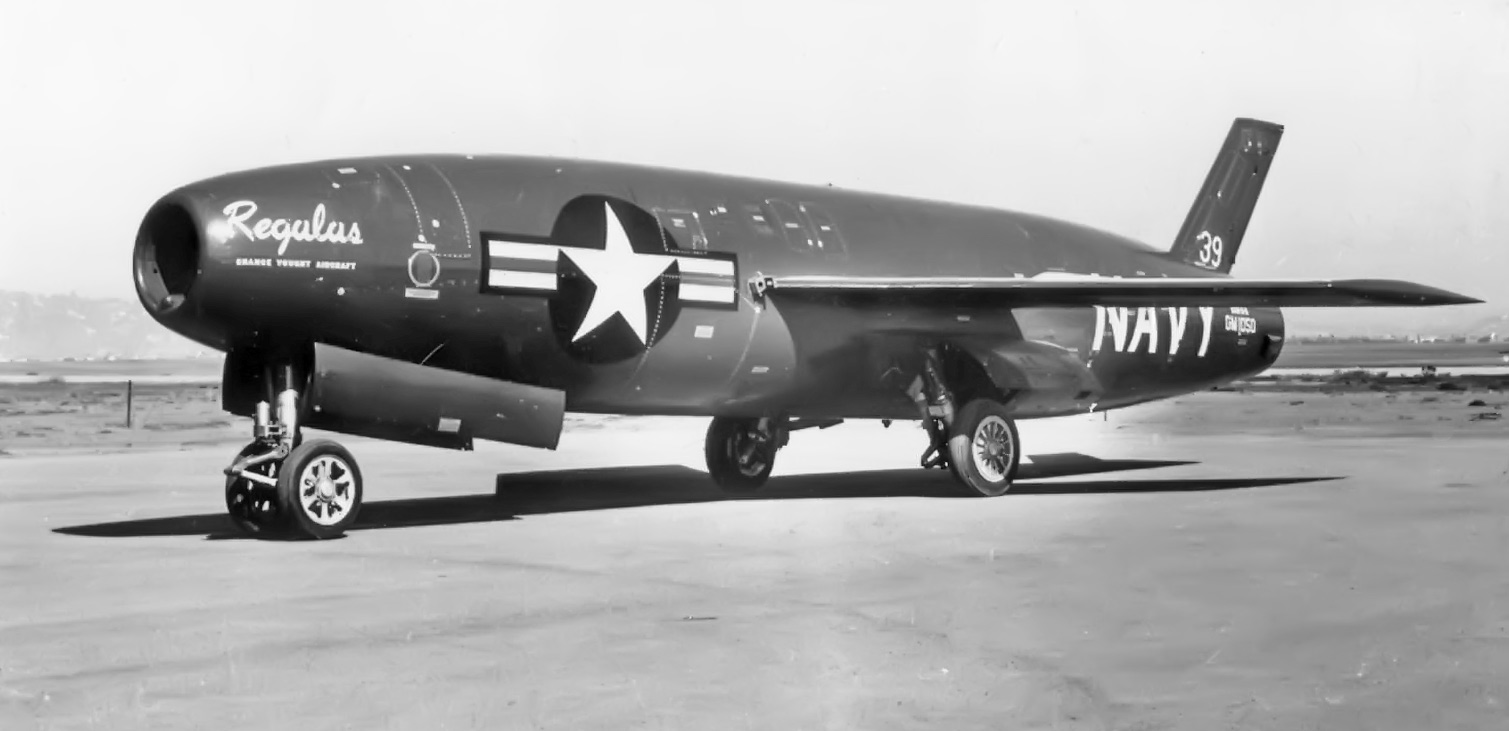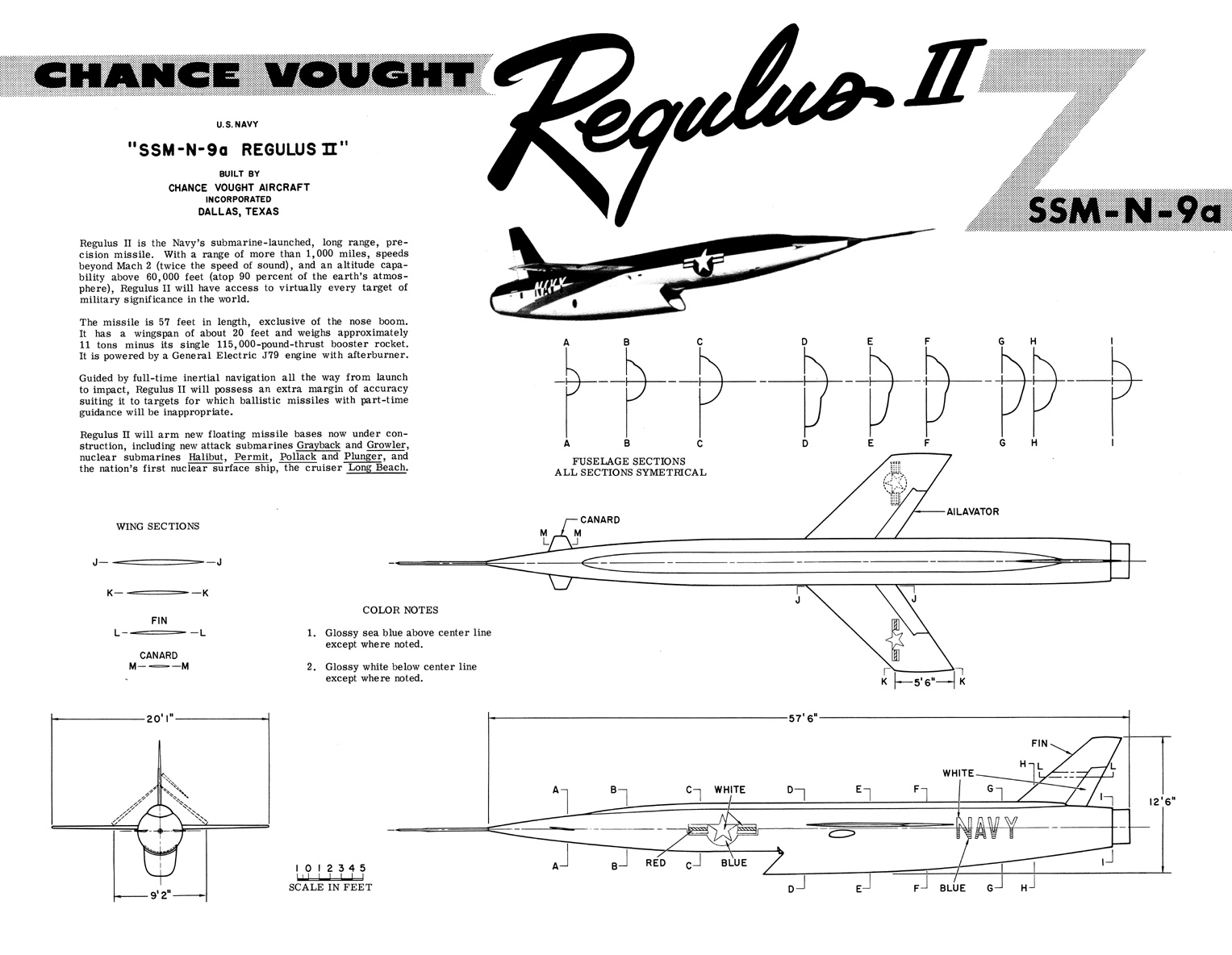Price: $39.95
- 5 magazines, 11 documents, & photos
- PDF contains 1,898 pages
- Content is keyword searchable
- Print a personal copy
- Pay via PayPal or Credit Card
- International orders welcome!
- Download files upon payment
April 2002
- Regulus, The Fleet’s First Guided Missile
- Republic’s F-105
- DC-1, Air Travel’s most significant Airliner Prototype
December 2002
- Regulus II, Sub-Launched Supersonic Missile
- Fokker F-32, America’s First Four-Engined Airliner
- Cessna A-37 Dragonfly
May 2004
- Winged Missiles of the USAF
- F7F Tigercats, Night Fighters in Korea
- Boeing’s Dash 80, Was it the airplane that changed the world?
September 2004
- Nuclear Nightmare, Almost
- North American’s incredible XF-108
- Lockheed Vega, Factory Fresh
- Itazuke Air Base Ramp Tour
- Swing-Wings, Bell X-5 to F-14
December 2006
- Army Missiles, Models of Yesteryear
- F-111s in Vietnam
- Convair B-58, Factory Fresh
Documents & Photos
- Aircraft Warning & Control System 1959-1980
- All Hands – Guided Missile Navy
- Cruise Missiles for the US Navy
- Evolution of the Cruise Missile
- Snark to Peacekeeper
- US Cold War Missile Program
- USAF Ground Launched Cruise Missiles
- SAGE BOMARC Defense System 1958.pdf
- Secrets of the BOMARC
- History of Inertial Guidance
- USAF Space Command 50 Years of Space & Missiles
- Over 400 winged & guided missile photos!
Snark
Regulus
Regulus II
Bomarc
Matador
Mace
Navajo
Nike Hercules
Nike Ajax
Northrop SM-62 Snark Specifications

- In service: 1959 – 61
- Weight: 48,150 pounds (21,850 kilogram) without boosters; 60,000 pounds (27,200 kg) with boosters
- Length: 67 feet, two inches (20.5 meters)
- Warhead: W39 thermonuclear warhead (explosive yield: 3.8 megatons)
- Engine: One Pratt & Whitney J57 jet engine; and two Aerojet solid-propellant rocket boosters
- J – 57 turbojet: 10,500 pounds (46.7 kilonewtons) of thrust; booster rockets: 130,000 pounds (580 kilonewtons) of thrust
- Wingspan: 42 feet, three inches (12.9 meters)
- Operational range: 5,500 nautical miles (10,200 kilometers)
- Flight ceiling: 50,250 feet (15,300 meters)
- Speed: 565 nautical mile/hour (1,050 kilometer/hour)
- Guidance system: Celestial navigation
Northrop SM-62 Snark missiles on Display
- Air Force Space & Missile Museum, Cape Canaveral Air Force Station, Florida. This pristine artifact is in sequestered storage in Hangar R on Cape Canaveral AFS and cannot be viewed by the general public.
- National Museum of the United States Air Force, Wright-Patterson Air Force Base, Dayton, Ohio
- Strategic Air & Space Museum, adjacent to Offutt AFB, Ashland, Nebraska
- Hill Air Force Base, Ogden, Utah
- National Museum of Nuclear Science & History, adjacent to Kirtland AFB, Albuquerque, New Mexico
- City of Presque Isle, Maine static display
Chance-Vought SSM-N-8 Regulus Specifications
- In service: 1955-64
- Produced: March 1951
- Weight: 13,685 pounds (6,207 kg)
- Length: 32 feet 2 inches (9.80 m)
- Diameter: 4 feet 8.5 inches (1.435 m)
- Warhead: 3,000 pounds (1,400 kg) such as the W5 warhead or the W27 warhead
- Engines: Allison J33-A-14 turbojet 4,600 lbf (20 kN), 2 × booster rockets 33,000 lbf (150 kN)
- Wingspan: 21 feet (6.4 m) extended, 9 feet 10.5 inches (3.010 m) folded
- Operational range: 500 nautical miles (926 km)
- Speed: Subsonic
Regulus on Display
- Carolinas Aviation Museum, Charlotte, North Carolina – 1956 Chance-Vought SSM-N-9a Regulus II cruise missile in launch position at the Carolinas Aviation Museum in Charlotte, North Carolina. It is mounted on a catapult launching stand used for aircraft carrier launches and was restored late 2006 after having been on outdoor display for a number of years.
- Frontiers of Flight Museum, Dallas Love Field, Texas – Regulus II missile
- Intrepid Sea-Air-Space Museum, New York City, New York – Regulus I cruise missile can be seen ready for simulated launch on board USS Growler at the Intrepid Sea-Air-Space Museum in New York City.
- Point Mugu Missile Park, Naval Air Station Point Mugu, California – The museum’s collection includes both a Regulus and a Regulus II missile
- USS Bowfin Museum, Pearl Harbor, Hawaii
- Veterans Memorial Museum, Huntsville, Alabama – Regulus II missile
- National Air and Space Museum – Regulus I on display at Steven F. Udvar-Hazy Center
- New Jersey Naval Museum, Hackensack, NJ – Regulus with intact engine
- US Navy Pacific Missile Range Facility, Barking Sands, island of Kauai, Hawaii – Regulus I restored in 2011 on static display inside the North Gate
Regulus Cutaway
Chance-Vought SSM-N-9 Regulus II Specifications
- Manufacturer: Chance Vought
- Produced: 1956
- Weight: 23,000 pounds (10,000 kg)
- Length: 57 feet 6 inches (17.53 m)
- Diameter: 50 inches (1.3 m)
- Warhead: W27 warhead
- Detonation mechanism: air burst or surface burst (air burst – fireball does not reach the ground, usually at least 10,000 feet in altitude, surface burst – fireball touches the ground, less than 10,000 feet in altitude)
- Engines: 1x General Electric J79-GE-3 turbojet, 1x Rocketdyne solid-fueled rocket, 15,600 lbf (69 kN) + 135,000 lbf (600 kN)
- Wingspan: 20 feet 1 inch (6.12 m)
- Operational range: 1,000 nautical miles (1,852 km)
- Flight ceiling: 59,000 feet (18,000 m)
- Speed: Mach 2.0
- Guidance system: Inertial
- Launch platform: SSG and SSGN class submarines, cruisers
Regulus II Variants
- SSM-N-9 Regulus II – The basic designation of the missile, pre-1964.
- SSM-N-9a Regulus II – The designation of production missiles, pre-1964.
- XRSSM-N-9 Regulus II – Prototype missiles fitted with retractable landing gear for land based development flights, powered by Wright J65 turbojet engines and Aerojet General booster rockets.
- XRSSM-N-9a – Prototype missiles fitted with retractable landing gear for land based development flights, powered by General Electric J79 turbojet engines and Rocketdyne booster rockets.
- YTSSM-N-9a – Development Training missiles with retractable landing gear.
- TSSM-N-9a – Production training missiles with retractable landing gear.
- KD2U-1 – Pre-1962 designation of the target drone version of the Regulus II
- RQM-15A – KD2U-1Regulus II target re-designated in April 1963.
- MQM-15A – KD2U-1 Target drones used for research and as targets for the IM-99 Bomarc SAM.
- GQM-15A – Gear equipped KD2U-1 target drones re-designated.
Regulus II on Display
- Frontiers of Flight Museum, Dallas Love Field, Texas – A Regulus II missile
- Point Mugu Missile Park, Naval Air Station Point Mugu, California – The museum’s collection includes both a Regulus and a Regulus II missile
- Veterans Memorial Museum, Huntsville, Alabama – A Regulus II missile
Boeing CIM-10 Bomarc Specifications

- Role: Ground-controlled interception
- First flight: 10 August 1952 – crashed: 168 (XF-99), 1954 October – successful (7th prototype), 1958 August – 1st production IM
- Introduction: 1959 September 1 (3 missiles)
- Retired: 1972 October 1
- Primary user: USAF & RCAF Air Defense Commands
- Number built: >100 “experimental and service-test”, 570 operational
Bomarc Variants
- XF-99 (experimental for booster research)
- XF-99A/XIM-99A (experimental for ramjet research)
- YF-99/YIM-99 (service-test)
- IM-99A (initial production)
- IM-99B (“advanced”)
- CQM-10 (target drone)
Bomarc On Display
- Air Force Armament Museum, Eglin Air Force Base, Florida
- Air Force Space & Missile Museum, Cape Canaveral Air Force Station, Florida. This pristine artifact is in sequestered storage in Hangar R on Cape Canaveral AFS and cannot be viewed by the general public.
- Alberta Aviation Museum, Edmonton, Alberta, Canada
- Canada Aviation and Space Museum, Ottawa, Ontario, Canada
- Hill Aerospace Museum, Hill Air Force Base, Utah
- Historical Electronics Museum, Linthicum, Maryland (display of AN/DPN-53, the first airborne pulse-doppler radar, used in the Bomarc)
- Illinois Soldiers & Sailors Home, Quincy, Illinois
- Keesler Air Force Base, Biloxi, Mississippi
- Museum of Aviation, Robins Air Force Base, Warner Robins, Georgia
- National Museum of Nuclear Science & History, Kirtland Air Force Base, Albuquerque, New Mexico
- National Museum of the United States Air Force, Wright-Patterson Air Force Base, Ohio
- Octave Chanute Aerospace Museum (former Chanute Air Force Base), Rantoul, Illinois
- Peterson Air and Space Museum, Peterson Air Force Base, Colorado
- Strategic Air and Space Museum, Ashland, Nebraska
- U.S. Air Force History and Traditions Museum, Lackland Air Force Base, San Antonio, Texas
- Vandenberg Air Force Base (Space and Missile Heritage Center), California. Bomarc not for public access.
Martin MGM-1 Matador Specifications
- In service: “A” (1952), “C” (1957)
- Weight: 12,000 lb
- Length: 39 ft 6 in
- Diameter: 4 ft 6 in
- Warhead: Nuclear W-5 (40 kt yield)
- Engines: 4,600 lbf (20,000 N) thrust Allison J33-A-37 Turbojet sustainer engine; 55,000 lb (25,000 kg) thust Aerojet General solid fuel rocket, 2 s burn
- Wingspan: 28 ft 7 in
- Operational range: 700 miles
- Flight altitude: 35,000 ft
- Speed: Approximately 650 mph (Mach 0.9)
- Guidance system: “A” Radar directed radio command guidance system; “C” same plus Shanicle
- Launch platform: Mobile launcher
Matador Variants
- MX-771: Original U.S. Air Force project number.
- SSM-A-1: Early proposed designation for operational missile. This designation was dropped before the first operational missiles were completed.
- XSSM-A-1: First designation applied to first prototypes for development of the missile airframe.
- YSSM-A-1: First designation applied to prototypes for development of the guidance system.
- B-61: Operational designation proposed to supersede SSM-A-1 designation. This designation was designed to classify the missile as a pilotless bomber.
- XB-61: Redesignation of the XSSM-A-1
- YB-61: Redesignation of the YSSM-A-1
- B-61A: First production version of the Matador. Principal difference from the XB-61 and YB-61 was redesign of the airframe with high wings in place of the previous mid-mounted wings.
- TM-61A: Redesignation of the B-61A as the USAF decided to classify the Matador as a tactical missile instead of a pilotless bomber.
- TM-61B: Significant redesign of the TM-61A, ultimately being redesignated as its own system, the TM-76 Mace.
- TM-61C: Improved TM-61A developed as a stop-gap as the TM-61B was under development.
- MGM-1C: Redesignation of the TM-61C in 1963 to meet new aircraft and missile designation standards adopted by the USAF. Only the TM-61C required redesignation as the TM-61A had been fully withdrawn from service and the TM-61B had been redesignated the TM-76 Mace, and ultimately received the MGM-13 designation.
Matador on Display
- Air Force Space & Missile Museum, Cape Canaveral Air Force Station, Florida. This pristine artifact is in sequestered storage in Hangar R on Cape Canaveral AFS and cannot be viewed by the general public.
- Carolinas Aviation Museum, Charlotte, North Carolina (this Matador was formerly on display at the Florence Air & Missile Museum in Florence, South Carolina)
- Museum of Aviation, Robins Air Force Base, Georgia TM-61A Serial #52-1891
- National Air and Space Museum, Dulles International Airport
- National Museum of the United States Air Force, Wright-Patterson AFB, Dayton, Ohio
- A “Bitburg”-Matador survives as a Missile Monument at the former 38th Combat Support Wing GLCM station “Pydna” at Wüschheim, Germany
- Luftwaffenmuseum der Bundeswehr, Berlin, Germany
- National Museum of Nuclear Science & History, adjacent to Kirtland AFB in Albuquerque, New Mexico
- A TM-61C Matador, Serial # 56-1955 is on display near Pikeville, NC in the parking lot of a church.
- “XTM-61” Serial #52-1872 is on static display at Hawkinsville-Pulaski County Airport, Hawkinsville, GA.
Martin MGM-13 Mace Specifications
General characteristics
- Length: 44 ft 6 in (13.6 m)
- Diameter: 4 ft 6 in (1.4 m)
- Launch mass: 18,000 lb (8,200 kg)
Engine
- First stage: 1× Thiokol solid fuel booster rocket
- Thrust: 100,000 lbf (445 kN)
- Second stage: 1× Allison J33-A-41 turbojet
- Thrust: 5,200 lbf (23 kN)
Technical information
- Launch platform: MM1: mobile trailer, CGM-13B: coffin
Performance
- Cruise speed: 650 mph (570 kn, 1,000 km/h)
- Operating altitude: up to 40,000 ft (12,000 m)
- Range: 1,400 mi (1,200 nmi, 2,300 km)
Warhead
- Warhead: Conventional or nuclear
Mace on Display
- Air Force Space & Missile Museum, Cape Canaveral Air Force Station, Florida
- Air Force Armament Museum, Eglin Air Force Base, Florida, CGM-13 Serial 59-4860
- Museum of Aviation, Robins Air Force Base, Georgia MGM-13A Serial 58-1465
- National Museum of the United States Air Force, Wright-Patterson Air Force Base, Dayton, Ohio. This Mace “B” was based on Okinawa prior to its delivery to the museum in 1971.
- Indiana Military Museum, Vincennes CGM-13B Serial 59-4871. This Mace B was assigned to the 4504th Missile Training Wing, Orlando AFB, Florida.
- Belleview Park, Englewood, CO. Elevated outdoor display. Serial no. unknown. Donated to the city by the Martin Company in the 1960s for use as playground equipment.
- White Sands Missile Range Museum, NM
- Public display in Memorial Park, Flagler, CO, s/n 81463.
- McDermott Post 452, American Legion, Mildred PA
North American SM-64 Navaho
General characteristics
- Length: 67 ft 11 in (20.7 m)
- Wingspan: 28 ft 7 in (8.71 m)
- Loaded weight: 64,850 lb (29,420 kg)
- Powerplant: 2 × XRJ47-W-5 ramjets, 15,000 lbf (67 kN) each, 2 × XLR83-NA-1 rocket boosters, 200,000 lbf (890 kN) each
Performance
- Maximum speed: Mach 3 (2,000 kn, 3,700 km/h)
- Range: 3,500 nmi, (6,500 km)
- Service ceiling: 77,000 ft (23,000 m)
- Thrust/weight (jet): 0.46:1
Armament
- 1 × W41 nuclear warhead
Navajo on Display
- The only Navaho missile in existence is currently displayed outside the south entrance gate of Cape Canaveral Air Force Station, Florida.
MIM-14 Nike Hercules Specifications
- Manufacturers: Western Electric, Bell Laboratories, Douglas Aircraft Company
- Weight: 10,710 pounds (4,860 kg)
- Length: 41 feet (12 m) overall, 26 feet 10 inches (8.18 m) second stage
- Diameter: booster 31.5 inches (800 mm), second stage 21 inches (530 mm)
- Warhead: initially W7 (2.5 or 28 kt)[1][verification needed] later W31 nuclear 2 kt (M-97) or 20 kt (M-22)[2] or T-45 HE warhead weighing 1,106 pounds (502 kg) and containing 600 pounds (270 kg) of HBX-6 M17 blast-fragmentation
- Engines: Booster: Hercules M42 solid-fueled rocket cluster (4x M5E1 Nike boosters) 978 kN (220000 lb), Sustainer: Thiokol M30 solid-fueled rocket 44.4 kN (10000 lb)
- Wingspan: 11 feet 6 inches (3.51 m) booster, 6 feet 2 inches (1.88 m) second stage
- Operational range: 90 miles (140 km)
- Flight ceiling: 150,000 feet (46,000 m)
- Speed: >Mach 3.65 (ca. 2750 mph or 4,470 km/h)
MIM-3 Nike Ajax Specifications
- In service: 1954
- Manufacturer: Bell Labs, Douglas Aircraft
- Unit cost: $19,300 (flyaway, 1958), $61,000 total
- Number Produced: 1952
- Weight: 32,259 lb (14.6 t) total, 31,051 lb (14.1 t) sustainer, 1,208 lb (0.5 t) booster
- Length: 32 ft 8 in (9.96 m) overall, 20 ft 11 in (6.38 m) sustainer, 13 ft 2 in (4.01 m) booster
- Diameter: 14.6 in (0.37 m) sustainer, 16.2 in (0.41 m) booster
- Detonation mechanism: radio command
- Engines: Solid fuel booster, liquid fuel sustainer 48,000–59,000 lbf (210–260 kN) booster, 2,600 lbf (12 kN) sustainer
- Wingspan: 50 in (1.3 m) sustainer, 76 in (1.9 m) booster
- Propellant: JP-4 and RFNA/UDMH (sustainer)
- Operational range: 30 mi (48 km)
- Flight ceiling: 70,000 ft (21,000 m)
- Speed: Mach 2.25 (1,710 mph; 2,760 km/h) (@ 50k ft)
- Guidance system: command guidance
- Launch platform: fixed erector/launchers
Nike Ajax on Display
- A Nike Ajax, Nike Hercules, and Nike Zeus are on display at the Redstone Arsenal in Alabama.
- A Nike Ajax and Nike Hercules are on display at the Royal Museum of the Armed Forces and Military History in Brussels, Belgium.
- A Nike Ajax and Hercules are on display at the Peterson Air and Space Museum in Colorado Springs, Colorado.
- A Nike Ajax missile is on display at Camp Nathan Hale, in Niantic, Connecticut.
- Two Nike Ajax and a Hercules are on display at the Cape Canaveral Space & Missile Museum in Cape Canaveral, Florida.
- A Nike Hercules is on display at Nike Missile Site HM-69, now a registered historic site located within Everglades National Park.
- A Nike Ajax is on display at the War Museum in Athens, Greece.
- A Nike Ajax and Hercules are on display in front of the VFW post in Cedar Lake, Indiana.
- A Nike Ajax is on display in Marion, Kentucky.
- A Nike Ajax and Hercules are on display at the Aberdeen Proving Grounds in Aberdeen, Maryland.
- A Nike Ajax is on display in front of the VFW post in Hancock, Maryland.
- Two Nike Ajax and a Hercules are on display at a small Cold War museum in Ft. Meade, Maryland.
- A Nike Ajax and Hercules are on display at the Dutch Air Force Museum in Soesterberg, Netherlands.
- A Nike Ajax is on display at The Space Center in Alamagordo, New Mexico.
- A Nike Ajax is on display near the administrative buildings at the former Nike site in Rustan, about 40 km to the southwest of Oslo, Norway.
- Two Nike Ajax and a Nike Hercules are on display near the Bataan Building at Camp Perry, near Port Clinton, Ohio.
- A Nike Ajax is on display near the Toledo Rockets Glass Bowl Stadium on the campus of the University of Toledo in Toledo, Ohio.
- A Nike Ajax is displayed in front of an Army Surplus store located near the Letterkenny Army Depot in Pennsylvania.
- A Nike Ajax and Hercules are on display at the Pennsylvania National Guard Department of Military Arts building at Fort Indiantown Gap, Pennsylvania.
- A Nike Hercules missile is used as a static display by the Rhode Island National Guard.
- A Nike Ajax and Hercules are on display at the Air Power Park in Hampton, Virginia.
- A Nike Ajax missile cutaway, as well as a complete Nike Ajax missile are on display at the Udvar-Hazy Center of the Smithsonian Air & Space Museum at Washington Dulles International Airport, in Washington D.C..
- A Nike Ajax and Nike Hercules are on display in the Berryman War Memorial Park in Bridgeport, Washington.
- A Nike Ajax is on display at the Ft. Lewis Military Museum in Tacoma, Washington.
- A Nike Ajax on its launcher is on display outside an American Legion hall in Okauchee Lake, Wisconsin.
- A Nike Ajax on its transporter (trailer) is on display outside a public storage (former site MS-20) facility in Roberts, Wisconsin.
- A Nike Ajax is on display in front of the American Legion Post in Waynesboro, Pennsylvania.
- A Nike Ajax is on display in front of the Combat Air Museum in Topeka, Kansas.
- A Nike Ajax is on display at the MUNA Military Museum, Marktbergel, Germany
Nike Ajax Bases
- The best preserved Nike installation is site SF88L located in the Marin Headlands just west of the Golden Gate Bridge in San Francisco, California. The site is a museum, and contains the missile bunkers, and control area, as well as period uniforms and vehicles that would have operated at the site. The site has been preserved in the condition it was in at the time it was decommissioned in 1974. The site began as a Nike Ajax base and was later converted to Nike Hercules.
- The second best preserved Nike installation is site NY-56 at Fort Hancock in Sandy Hook, New Jersey. The site has been restored and contains the original missile bunkers, as well as three Nike Ajax and a Nike Hercules on display. The site is on the National Register of Historic Places.


